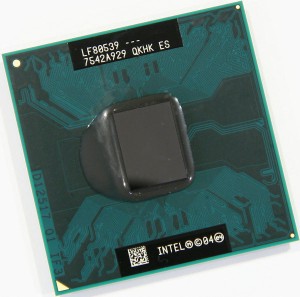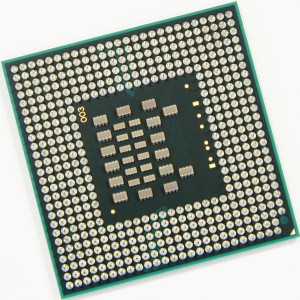Core
Duo close up
If you've been hanging around here for a while, you may
have heard us referring to Core Duo by its code name,
Yonah, long before Intel decided to give it a somewhat
confusing official name. We previewed Yonah after last
fall's Intel Developer Forum, explaining some of the features
that make it unique. Like other dual-core processors such
as the Pentium D and the Athlon 64 X2, the Core Duo joins
together a pair of CPU cores on a single chip. In the
case of the Core Duo, those CPU cores are massaged and
tweaked versions of the Pentium M processor, familiar
as part of Intel's Centrino mobile platform. (The Pentium
M itself traces its heritage back through many earlier
Pentiums, including the Pentium III and Pentium Pro; we've
covered the Pentium M at some length in the past.)
Unlike the Pentium D, however, the Core
Duo benefits from a very intentional dual-core design.
In fact, the Core Duo's two cores are arguably more
tightly integrated than those in AMD's dual-core Athlon
and Opteron processors. Each of the Duo's cores has
a 32KB L1 cache for data and another of the same size
for instructions, but the cores share a common 2MB L2
cache via an internal, on-chip bus. Space in the L2
cache is allocated dynamically, so either core can allocate
up to the full 2MB of cache for itself, should the other
one not need it. The two cores can effectively share
the data in the L2 cache, as well. This use of a single,
unified L2 cache greatly simplifies the management of
cache coherency, especially in a single-socket system
like a laptop or desktop PC. With the Pentium D, by
contrast, cache coherency updates must constantly be
passed across the system's front-side bus, even in a
single-socket system.
Core Duo is more than just a pair of
Pentium Ms made to share a cache, though. Intel's Israel-based
CPU design team has modified the Pentium M design in
order to address some of its performance shortcomings,
especially in terms of multimedia performance. Simply
going from a single core to two will inevitably help
speed up tasks like video encoding, where the software
is typically multithreaded. But Yonah also supports
the group of 13 new instructions known as SSE3, handles
some SSE2 instructing like Shuffle and Unpack up to
30% faster, and is capable of using its instruction-grouping
abilities (known as micro-ops fusion) on some SSE instructions,
improving overall throughput. These and other enhancements
should help alleviate some of the Pentium M's few performance
weaknesses compared to today's desktop processors.
 Of
course, none of these enhancements would matter much
if Intel couldn't fit the Core Duo into laptops with
about the same size, weight, battery power, and cooling
capabilities as the Pentium M. In order to make that
happen, Intel has arrayed a number of technologies in
Core Duo's favor, not least of which is its 65-nanometer
chip fabrication process. The process shrink means Core
Duo's 151 million transistors can reside in an area
only 90 mm2—barely any larger than the single-core
Pentium M "Dothan" at 84 mm2 when manufactured
with Intel's 90-nano process. The Core Duo also benefits
from the fortuitous effects of multi-core processor
designs on power consumption; by keeping clock frequencies
relatively low and doubling up on CPU logic, a dual-core
CPU can generally achieve better performance per watt
than a single-core CPU, provided that multithreaded
software is reasonably abundant. Of
course, none of these enhancements would matter much
if Intel couldn't fit the Core Duo into laptops with
about the same size, weight, battery power, and cooling
capabilities as the Pentium M. In order to make that
happen, Intel has arrayed a number of technologies in
Core Duo's favor, not least of which is its 65-nanometer
chip fabrication process. The process shrink means Core
Duo's 151 million transistors can reside in an area
only 90 mm2—barely any larger than the single-core
Pentium M "Dothan" at 84 mm2 when manufactured
with Intel's 90-nano process. The Core Duo also benefits
from the fortuitous effects of multi-core processor
designs on power consumption; by keeping clock frequencies
relatively low and doubling up on CPU logic, a dual-core
CPU can generally achieve better performance per watt
than a single-core CPU, provided that multithreaded
software is reasonably abundant.
The
Core Duo T2600 processor
These
moves to 65nm and dual cores are big steps in the fight
to keep power consumption in check, but Intel didn't
stop there. They've also given the Core Duo a range
of power management techniques that can reduce power
use when part or all of the processor is idle. The two
cores can independently manage some of their own traditional
low-power states or C-states, such as Halt, Stop-Clock,
and Sleep, so that one core could enter a lower power
mode while the other cranks away on a thread. More innovatively,
the Core Duo can choose to deactivate portions of its
shared L2 cache in stages if the current applications
don't require full use of the cache. Unneeded parts
of the cache are flushed to memory and temporarily shut
down. Should the CPU become so idle that the entire
L2 cache can be flushed to RAM, the Core Duo will enter
what Intel calls an Enhanced Deeper Sleep mode. In this
state, without the need to power the L2 cache, the processor
can operate at even lower voltages. Such C-state transitions
happen in fractions of a second, so entering or recovering
from a low-power state should be largely imperceptible
to the end user. Core Duo also carries over Intel's
Enhanced SpeedStep dynamic clock speed and voltage scaling
feature, of course, and it adds new thermal sensors
on each CPU core near likely hotspots on the chip.
Thanks
to all of these changes, Intel rates the TDP, or thermal
design power, of the first wave of Core Duo chips—ranging
from 1.66GHz to 2.166GHz—at only 31W. (TDP is
a design target for cooling solutions and doesn't necessarily
represent the peak power draw of the part.) That's up
only slightly from the 27W TDP of the faster variants
of the Dothan, like the Pentium M 770 at 2.13GHz. Intel
makes a single-core variant of Yonah called the Core
Solo, and its TDP is 27W. There are also low-voltage
versions of Core Duo with TDPs as low as 15W. All in
all, that's a mighty impressive achievement for a processor
with this sort of performance.
The
Core Duo is packed to the hilt with the latest features,
including SSE3, support for the Execute Disable Bit
for better antivirus protection, and Intel's new VT
virtualization technology. The one omission from this
list of CPU enhancements is a notable one, though: Core
Duo lacks support for EM64T, Intel's version of the
64-bit extensions to the x86 instruction set pioneered
by AMD. Without 64-bit support, the Core Duo can't easily
address more than 4GB of memory, and it loses out on
the potential performance gains offered by x86-64's
additional registers. Being stuck at under 4GB won't
matter much for the Core Duo's success in mobile applications,
and it's not likely to harm its prospects inside of
Intel's Viiv-branded home theater PCs. For really beefy
desktops, workstations, and especially servers, though,
64-bit support is becoming much more important with
time. We will have to wait for Core Duo's successor,
code-named Merom and based on Intel's next-generation
Core microarchitecture, for 64-bit capabilities in an
Intel mobile processor.
Core
Duo is part of Intel's newfangled Centrino platform,
code-named Napa. The Core Duo's main companion in the
Napa scheme is the mobile version of Intel's 945G core
logic chipset, the 945GM. The 945GM north bridge chip
is linked to Core Duo by means of a 667MHz system bus,
and the 945GM's memory controller supports dual channels
of DDR2 memory at up to 667MHz. That gives the chipset
twice the effective bandwidth of the front-side bus,
a disparity Intel has accepted as normal. In many Centrino-based
laptops, the excess bandwidth will be used to feed the
945G's integrated graphics processor, the GMA 950.
In
part because it needs this new chipset with support
for higher bus speeds, the Core Duo is not a drop-in
replacement for the Pentium M. In fact, although it
has 479 pins on its belly, the Core Duo uses a different
pin layout than the Pentium M, making it physically
incompatible with older Socket 479 motherboards
|